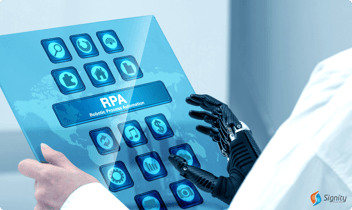Pros and Cons of Commercial vs. Open Source RPA
For bigger companies, open-source RPA bridges the gaps that commercials may not fill. Whereas, with commercial tools, you don’t need a robust in-house team with skills to get up and running. Here, we compare commercial and open-source RPA technologies to help you make an easier choice.
.jpg?width=670&height=445&name=Top%20Open-Source%20RPA%20Frameworks%20(2).jpg)
By now, even the least digit heads among us have heard of Artificial Intelligence, Machine Learning, and Robotic Process Automation.
These technologies and tools bring jitters among employees who worry about losing their jobs to robots one day. But that technology, especially RPA, drives great benefits for the workforce.
RPA saves employees countless hours on manual tasks, offering them more time and focus on putting on activities that move the needle. After all, improving efficiency should be your top priority when it comes to expanding your business.
But, have you ever wondered how these tasks are automated?
RPA automates these tasks by building software bots that understand and mimic (and improve) human action within or across different applications, and accomplish the tasks quicker and with minimal mistakes.
Now, you may ask - “How much faster?”
Well, according to the McKinsey report - RPA has the potential to minimize organizational and administrative expenses by 30-50%. And, since your software bot:
- Doesn’t take off
- Minimizes costly errors
- Is present in many places at once
Simply put, it can scale, therefore minimizing your overhead and maximizing your bottom line in one full sweep.
However, you can use two types of RPA tools to leverage the benefits of automation - Open-Source RPA and Commercial RPA.
Don’t worry if you are at square one; here, we’ll explain what defines commercial and open-source RPA and its pros and cons. Let’s start!
Commercial RPA - Pros and Cons
Commercial RPA is a software technology that allows businesses to automate repetitive and rule-based tasks. Commercial RPA is a paid software product - often packed as a SaaS or on-premise solution and licensed by the tool or how many bots are installed. These products have a dedicated team working on them to ensure no glitch happens and keep them updated.
Remarkably, commercial RPA brings dedicated channels for support through resources, from customer service teams to blogs and forums about the products.
Pros of Commercial RPA
If you are considering commercial RPA, consider these benefits as it’ll help you understand why.
Complicated Automation
Commercial RPA tools are paid products developed by a team of professionals. And because of this, they are inclined to have an easy-to-understand learning curve for RPA developers to start their automation journey. Otherwise, the businesses that develop them couldn’t stay competitive.
Extensive array of Integrations
Commercial RPA programs often interact with more applications within your business. Once again, the competitive nature of the marketplace curates that commercial tools integrate well with your business’s other software.
Easy, Consistent Updates
With the help of commercial RPA shed the onus of worrying about commercial RPA updates. The company that licenses the software to you has a dedicated team that handles everything on its end.
Cons of Commercial RPA
With such remarkable benefits, there are some challenges that you must know.
It’s Expensive
This is true - commercial RPA costs money. The industry leaders tend to be a significant investment, saving you time and money in the long run. However, they may not be prudent until your business earns enough revenue and has included complicated systems and processes to warrant such an investment.
You Need to be a Tech-Savvy
Often, to automate a complete process or accomplish the most efficient solution, additional coding knowledge beyond what the RPA service provider offers out of the box is needed. Furthermore, the additional code unlocks the additional benefits where commercial RPA tools fell short.
Potential Infrastructure Changes
There’s no doubt small automation is easy to implement from an automation perspective. However, automation on a bigger scale may necessitate some significant changes to your IT infrastructure. Eventually, this boils down to cost/benefit - “Can bigger automation bring high ROI to validate the costs involved”?
On the other side, small automation often needs significant IT infrastructure to stand up for organizations just starting in the RPA world. Plus, customers are often challenged by the up-front IT investment to justify the need for their smaller automation.
Open Source RPA - Pros and Cons
As you likely understand, Robotic Process Automation - popularly known as RPA helps businesses automate manual, voluminous, and multi-step tasks effortlessly. Open Source RPA is no different; the only subtle difference is that it’s free to use and modify, meaning businesses can save on licensing fees.
So, now you must be wondering why is open source RPA - as opposed to closed source RPA - especially beneficial for businesses.
It offers a strong foundation to build customized robots without engaging with a commercial vendor, whose tech stack usually offers limited capabilities and expensive upfront costs.
Pros of Open Source RPA
If you are at the edge of making a choice, it’s impossible to understand the significant benefits of opting for open-source RPA.
It’s a Real Steal
For small and mid-sized businesses, licensing a complete RPA tool may be prohibitively expensive, especially if they’re starting to understand the benefits of software robots. Open source is a low-risk approach to getting started with RPA, especially if you have a strong, tech-savvy, experienced team.
It’s More Scalable
Open source RPA can be easily implemented in scenarios where licensed RPA doesn’t fit. For example, businesses that are planning to automate numerous financial reports at the end of every quarter get locked into a long-term contract for a service they use four times a year.
Here, open source offers the adjustments to only use the bot when needed.
It’s More Customizable
Open-source RPA tools are built to be easily customizable and editable, so you can build the optimal software bot to cater to your business's unique needs. On the contrary, proprietary platforms have pre-built automation that is difficult to edit and integrate.
Cons of Open Source RPA
With unskippable benefits, there are some significant drawbacks. Here are some issues you should pay attention to:
Security is a Concern
Of course, companies need visibility in their open-source code and a clear understanding of what code is written and what it is doing across applications and systems. Besides, companies will need to rely on additional tools that can be used to audit open-source code for known vulnerabilities and databases that can be searched for comprehensive information and remediation guidance.
Build Vs. Buy
Open-source is fundamentally free, though the trade-offs are the classic build vs buy conundrum.
For open-source to be a completely featured solution that delivers value, companies will be required to invest engineering hours to create and support the solution. So, identifying whether something is easier to buy (i.e. commercial RPA) vs. build (open-source RPA) is driven by priorities and what trade-offs companies may want to make or not.
Support is Limited
With open-source, there are approximately 1-800 numbers to call or support email addresses to resolve your errors or issues. As already known, open-source software is built decentralized and collaborative, solely relying on peer review and the open-source community for support. This means customers and users would depend on the developer community and their respective teams for any bugs or issues to be resolved.
Finally
No tool outweighs the other; indeed, it depends on what type of organization you run.
Big businesses with complicated IT and security requirements might go with commercial tools. After all, commercial RPA offers an out-of-the-box solution with dedicated support. In exchange, larger firms will spend a hefty amount, and the outcomes are worth it.
Whereas smaller or medium-sized businesses have the choice of an open-source solution. The pocket-friendly nature makes it easy for these companies to test the waters of RPA without committing the requisite dollars to a commercial solution - as long as they account for the efforts required to create and deploy an open-source solution.
Frequently Asked Questions
Have a question in mind? We are here to answer.
What is the difference between commercial and open-source RPA?
![]()
Commercial RPA software is typically sold as a subscription service or as a license, while open-source RPA software is free to use and modify. Commercial RPA software typically offers more features and support than open-source RPA software, but it is also more expensive. Open-source RPA software is a good option for businesses that want to save money or have more control over their RPA solution.
What are the pros of using commercial RPA?
![]()
The pros of using commercial RPA include:
- More features and support: Commercial RPA software typically offers more features and support than open-source RPA software. This can be helpful for businesses that need a more complex or demanding RPA solution.
- Easier to implement: Commercial RPA software is typically easier to implement than open-source RPA software. This is because commercial RPA software vendors typically offer a more comprehensive set of tools and documentation.
- More secure: Commercial RPA software is typically more secure than open-source RPA software. This is because commercial RPA vendors typically have more experience in security and have a vested interest in keeping their software secure.
What are the cons of using commercial RPA?
![]()
The cons of using commercial RPA include:
- More expensive: Commercial RPA software is typically more expensive than open-source RPA software. This is because commercial RPA vendors need to recoup the costs of development and support.
- Less flexibility: Commercial RPA software is typically less flexible than open-source RPA software. This is because commercial RPA vendors need to ensure that their software is compatible with a wide range of businesses.
- Vendor lock-in: Commercial RPA software can lead to vendor lock-in. This is because businesses that use commercial RPA software may become dependent on the vendor for support and updates.
What are the pros of using open-source RPA?
![]()
The pros of using open-source RPA include:
- More affordable: Open-source RPA software is free to use and modify. This can save businesses a significant amount of money.
- More flexible: Open-source RPA software is more flexible than commercial RPA software. This is because businesses can customize open-source RPA software to meet their specific needs.
- More control: Businesses have more control over their RPA solution when they use open-source RPA software. This is because businesses can choose the open source RPA software that best meets their needs and they can modify the software to meet their specific requirements.


%201-1.webp)


.png?width=344&height=101&name=Mask%20group%20(5).png)








-1.webp?width=352&name=ezgif.com-gif-maker%20(45)-1.webp)







